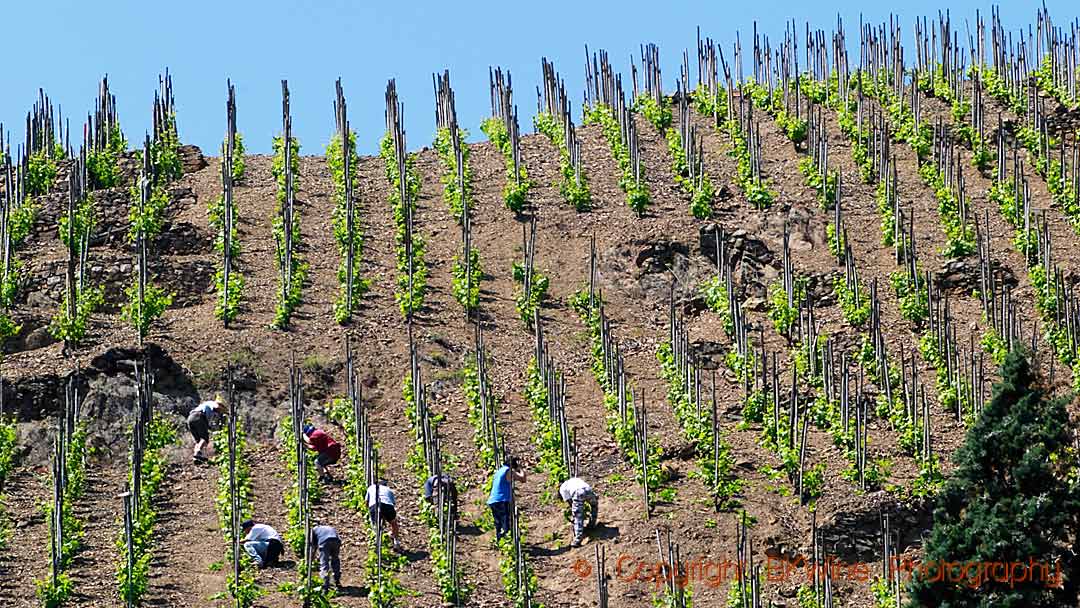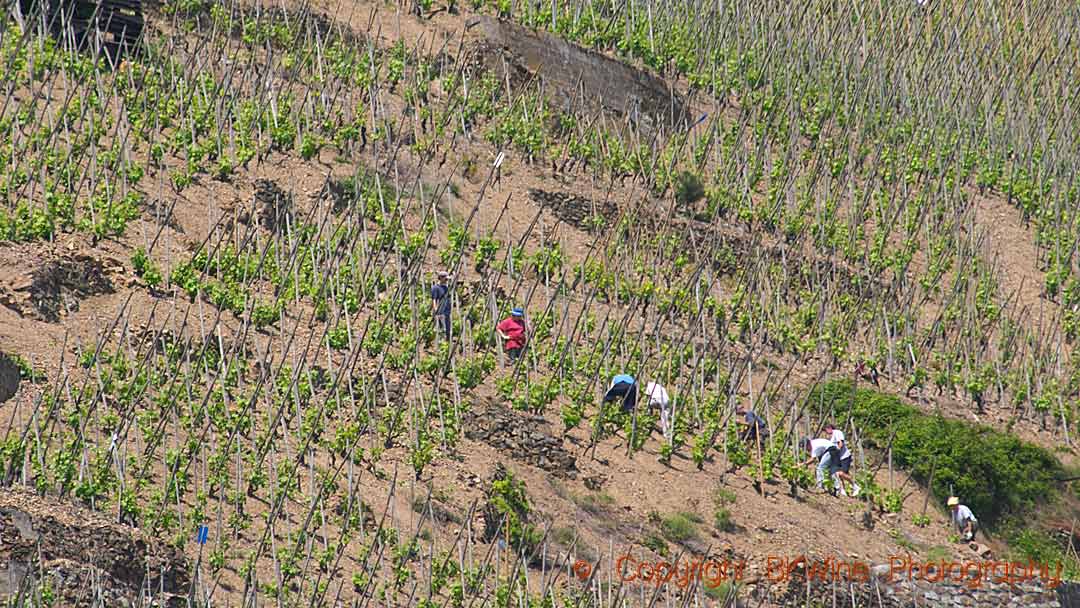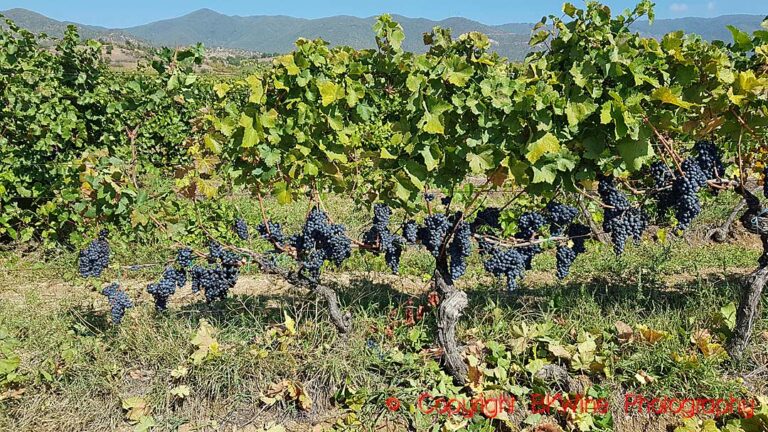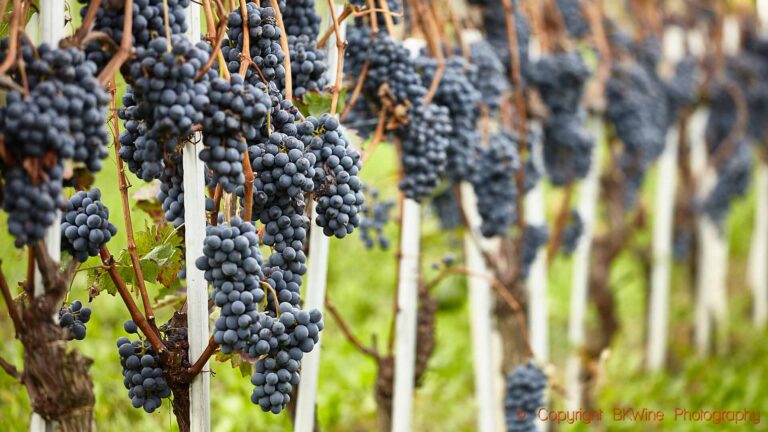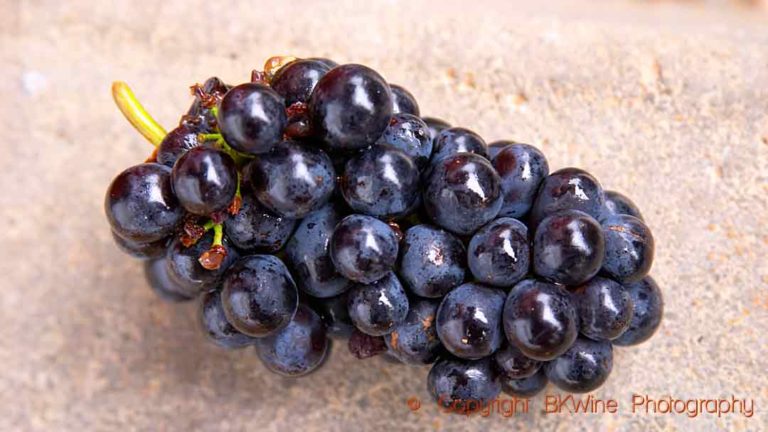Viognier has its “home” in the Rhône district, in the two small appellations Condrieu and Château Grillet. Until the end of the 20th century, it was hardly found anywhere else in France or any other wine country. Today that is no longer the case, which is good. It has become popular in single-variety wines and as a blended grape in Languedoc wines. It has also spread far beyond France’s borders, including Italy, the United States, Chile, Australia and South Africa.
Viognier is a quality grape but a difficult one that requires careful work in the vineyard and attention at the vinification. If you succeed with viognier, you get a wine with an almost overwhelming floral character on the nose but also dried apricots. The taste is full-bodied, almost oily. A wine with a strong personality that is suitable both as an aperitif and with a robust fish dish, but also, for example, foie gras and white asparagus.
Condrieu
Viognier is most expressive in Condrieu, where the grapes grow on neck-breaking steep slopes. The soil consists, among other things, of a special kind of granite which is locally called gores and which easily withers. The terraced slopes must therefore be kept in place with walls. Soil erosion in heavy rain is not an unusual phenomenon, and the winegrower will then simply have to retrieve the soil from the bottom of the slope and put it back. Just one of the many demanding tasks in the every-day life of a Condrieu farmer. These hard-to-work slopes, combined with the challenging viognier, which is easily attacked by disease and which does best if you keep the yield low, can make you understand that Condrieu was almost on the verge of disappearing as a wine district a few years ago.
From being a thriving district in the 19th century, the vineyard area in 1965 was down to eight hectares. Growing wine here was not profitable (how times change!) and very laborious on the steep slopes. The farmers pulled up the vines and planted fruit – apricots, peaches, cherries – and flowers instead.
The renaissance of the wine came in the early 1980s, and in 1986 the area had grown to 20 hectares. Today it has reached 170 hectares. It grows a bit every year. One of the new successful growers, André Perret (see further below), told BKWine Magazine a few years ago that he planted something new every year. He had bought a steep, wooded slope which he gradually cleared and replanted with viognier.
Château Grillet
Château Grillet is one of the more original appellations in France, partly due to its size. The entire appellation is no larger than just over 3 hectares and consists of only one property. The same family owned the property, Neyret-Gachet, since the 1830s but was bought in 2011 by François Pinault, one of France’s wealthiest persons.
Château Grillet is also a bit special because it’s a bit hard to understand why it actually got its own AOP instead of being part of Condrieu. Those who claim insight say that the soil here is a little different and that the location – the vineyard is shaped like an amphitheatre facing south – enjoys an extraordinarily sunny and warm climate. Temperatures of 40 degrees in summer are not uncommon. You can see the Château Grillet from the N86 if you stop at Vérin, about a kilometre south of the small town of Condrieu.
Condrieu begins just south of Ampuis, the capital of the Côte Rôtie, and continues down past the town of Condrieu and the villages of Malleval, Chavanay and Limony, a distance of just over 10 kilometres. From Chavanay down to Limony, the appellation shares land with Saint-Joseph. If you grow viognier here, it will be Condrieu, and if you have syrah, it will be Saint-Joseph, as it will be if you make white wine from marsanne and roussanne.
But viognier is now appearing in more and more places. Several wine growers have accepted the challenge and are starting to plant viognier outside the two original appellations, especially in the southern Rhône (a white Côtes-du-Rhône can be made from 100% viognier) and in the Languedoc. The advantage of this expansion of “new” viognier wines is that these are much cheaper and even if they do not quite reach the same class as a good Condrieu, they are often excellent.
Let’s visit two of the top producers in Condrieu and Saint-Joseph.
Domaine Pierre Gaillard, Malleval
A short distance from the river, up winding roads and with a breath-taking view, you can find Domaine Pierre Gaillard. Pierre started his career at a winery called Vidal-Fleury in Ampuis. In fact, it was Pierre who planted the vines on the La Turque slope in 1982, today one of Guigal’s icon wines, that Guigal got as part of the package when he bought Vidal-Fleury in 1986.
During his time at Vidal-Fleury, Pierre planned his own business and bought and planted some land. In 1987 he made his first vintage of Saint-Joseph. The estate has now grown to around 80 hectares of Saint-Joseph, Condrieu, Côte Rôtie, IGP des Collines Rhodaniennes but also vineyards in Banyuls in Roussillon (Domaine Madeloc) and in Faugères in Languedoc (Domaine Cottebrune). All his wines are excellent. The white Saint-Joseph is made from only roussanne, a lovely aperitif wine, floral and aromatic. His Condrieu is incredibly complex and aromatic, with flowers, peaches and apricots on the nose and a very long taste.
In addition to his red “standard” Saint-Joseph, Gaillard makes two other Saint-Josephs, from different plots. The regular Saint-Joseph gets 18 months of barrel ageing (of which 10% new barrels) and has a spicy, very typical syrah character. Saint-Joseph Clos de Cuminaille has more fruit and complexity (also 18 months in barrels, but 40% new). Saint-Joseph Les Pierres, aged in 100% new barrels for 18 months, is powerful, a bit meaty, with tar/asphalt on the nose and goes very well, according to Pierre Gaillard, with venison.
Domaine André Perret, Verlieu
The first vintage André Perret made was 1982 when he took over his father’s tiny property of 0.5 hectares. At that time, the family lived mainly from growing fruit and flowers. André made sure to expand the vineyard area and initially bought land in two different locations in Condrieu and then in Saint-Joseph. Now the property has grown to 13 hectares and continues to grow little by little each year. Over the years, André has built up a very loyal customer base, and the wines are sold out quickly.
He loves to experiment and sometimes makes a vendange tardive (late harvest) which he does not always bottle separately but might put into the final blend. He makes an exciting wine called Syrah Franc de Pied, which means that the vines are not grafted onto American root-stocks (resistant to phylloxera). The vines were ungrafted when André bought the plot from a retired winemaker who was simply a little too stingy to shop at the nursery. Instead, he planted in the traditional way by taking cuttings and did not bother with any grafting. And the vines survive year after year. Maybe the wine lice get dizzy up there on the steep slopes.
André makes three fine Condrieu and a white Saint Joseph. Condrieu Clos Chanson comes from a clayey soil that tends to accentuate the aromatic character of viognier. Condrieu Coteau de Chery grows in a more powerful soil with granite and silicate that is said to give better ageing potential to the wine. He also makes two white IGP des Collines Rhodaniennes, a lovely marsanne with a good body, apricot and almond and the other a viognier.
The red wine from ungrafted plants is also an IGP Collines Rhodaniennes, as an odd merlot-syrah-cuvée also is and an IGP which is a pure merlot. His best red wines, however, are two different Saint-Josephs.


